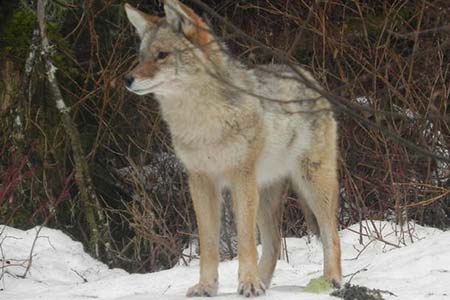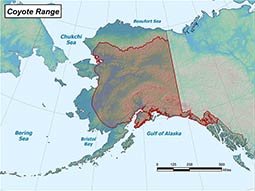Coyote
(Canis latrans)
Species Profile
Did You Know?
The coyote is a newcomer to Alaska. Coyotes were first noted in the state shortly after the turn of the 20th century. Populations were first reported on the mainland of Southeast Alaska and then slowly expanded northward into the upper Tanana Valley from which they radiated in all directions.
General Description
The coyote, like the wolf, is a member of the dog family (Canidae) and resembles a medium-sized shepherd-collie type dog. Distinctive features of the coyote are its sharp pointed ears that never droop, a sharp pointed nose, and long bushy tail. The legs of the coyote are generally slimmer and the feet smaller than those of a dog of comparable size. Coyotes average 22 to 33 pounds (10-15 kg) or about one-third the size of wolves. Males are slightly heavier than females. Coyotes average 2 feet high (.6 m) at the shoulder and, including tail, are approximately 4 feet (1.2 m) long. The summer coat is predominantly gray, washing into tan along the belly, lower legs, muzzle, and ears. Some guard hairs are tipped with black, as is the tail. The upper lip and underside are whitish. The intensity and amount of coloring varies, and individuals are usually lighter in winter.
Life History
Growth and Reproduction
Coyotes breed between January and March. A mated pair may stay together through the spring and share parental duties after the pups are born. Other coyotes, especially young of the previous years, may also help care for the pups. Shortly before whelping, one or more dens are prepared for the litter. Coyotes give birth to an average of five to seven blind and helpless pups. The size of litters varies in response to the food supply. Litters born in times of plenty will, on the average, be larger than those born when food resources are scarce. For the first three weeks the young coyotes subsist entirely on milk. About this time some solid food regurgitated by the females is introduced into their diet, and the pups are weaned at five to seven weeks. Once the pups establish a pattern of eating regurgitated food they will induce the parents to regurgitate by licking, biting, and clawing at their lips. At the age of three to three-and-a-half months, pups are able to capture food for themselves.
Coyotes are quick to respond to increases or decreases in prey. They have fewer pups when food is scarce, or they can have large litters when food (in Alaska, primarily snowshoe hares) is abundant. One Alaska researcher found if there’s a lot of prey and not much competition, coyotes have really big litters.
Coyotes den in a variety of protected places and frequently take over the dens of other animals. It is not unusual for coyotes to move their pups to other dens. Family units may begin to break up as early as August, although is not unusual for them to remain together into November or even later.
Coyotes form a strong pair bond. The typical social structure is a mated pair and offspring and most offspring disperse in the first year. In Alaska, coyotes are found mostly as mated pairs with an established territory. Lone coyotes are not unusual, but are generally transients without established territories. Packs of coyotes are unusual in Interior Alaska. Researchers Laura Prugh and Steve Arthur found that in Interior Alaska, a territory was about 40 square kilometers, which is really big for coyotes. In Texas several coyotes may have territories within a square kilometer, due to the abundance of food and greater diversity of prey.
The coyote may be the most vocal of the canids and is sometimes referred to as the “song dog.” The most common call is a long, mournful high-pitched howl which ends in a series of sharp yips and yaps. The howl of the coyote has a somewhat ventriloquistic effect, and it has often been reported that the howling of two or three coyotes sounds like a dozen or more animals are involved.
Like other canids, the coyote is susceptible to rabies, distemper, and other diseases which may cause periodic declines in coyote populations. Because of competition, coyotes are absent or scarce where wolves are abundant, and foxes are similarly less abundant where coyotes are numerous.
Feeding Ecology
The coyote is best described as an opportunistic feeder. In Alaska snowshoe hares, microtine rodents (voles), and carrion comprise the bulk of the coyote's diet while marmots, ground squirrels, muskrats, fish, insects, and even Dall sheep are taken in fewer numbers.
Coyotes hunt singly, in pairs, and occasionally in packs. They sometimes hunt cooperatively and have been observed using techniques such as chasing prey animals in relays, which allows them to capture animals that could outrun a single coyote. The coyote's method of capturing microtine rodents is similar to that of the fox. Upon locating its prey, the coyote makes a high, arching jump and pins the rodent to the ground with its forepaws. Often the prey is trapped under a mat of surrounding vegetation through which a more direct approach would be difficult.
Researcher Laura Prugh collected 1,500 scats from 56 different coyotes in Interior Alaska. She found a wide array of birds, mammals (including porcupine) and even plants in scat. In that study, porcupines were less than one percent the coyote diet when hares were abundant, but when hare abundance was low, porcupine went up to about 15 percent of the diet. In terms of average biomass, one porcupine equals seven hares or 350 voles. It’s not a bad meal if a coyote can catch one.
Although coyotes are opportunists, they developed different hunting skills and strategies. Some coyotes focus on small rodents, others target carrion. In the long run, some strategies had their risks. Coyotes scavenging carrion sometimes had to face wolves, and Prugh found two coyotes that were killed by wolves. She also found two coyotes that succumbed to quill injuries from porcupines.
Coyotes will hunt cooperatively, but it depends on what they’re hunting. Before wolves were reintroduced to Yellowstone, coyote packs with as many as 10 animals would successfully hunt elk. Prugh said with hares, a common strategy is for a pair to trot through the woods, flushing and then chasing down the prey. With small mammals, coyotes are most successful when hunting alone.
Occasionally the coyote finds itself on the other end of the “dinner table.” Great horned owls, bald and golden eagles, wolves, and bears all have been known to prey on coyotes. In some locations, free-ranging dogs will readily kill coyotes when the opportunity presents itself. Wolves kill coyotes, viewing them as both food and competition. When wolves were reintroduced to Yellowstone National Park in the 1990s, the number of coyote dropped significantly.
Range and Habitat
Coyotes were first noted in the state shortly after the turn of the 20th century. Populations were first reported on the mainland of Southeast Alaska and then slowly expanded northward into the upper Tanana Valley from which they radiated in all directions. A population peak occurred around 1940; since that time numbers have declined in many areas. There are few records of the coyote north of the Yukon River, although they do occur in this area. Portions of the state with the highest densities of coyotes are the Kenai Peninsula, the Matanuska and Susitna valleys and the Copper River Valley.
Status, Trends, and Threats
Status
In the wake of people’s relentless expansion into wildlife's domain, few species have been able to coexist and even expand their range as well as the coyote. The elimination or reduction of wolves from many areas of North America, coupled with land and clearing activities, have contributed to this range extension.
The major source of the coyote's conflict with man has been its fondness for sheep and poultry. Though only a few individuals are usually involved in such cases, massive predator control programs using poisons such as 1080 and strychnine, “coyote getters” loaded with cyanide, traps, aerial shooting, and bounties have been used against the coyote. In many states these weapons were very effective, and numbers of coyotes were greatly reduced. Alaska was not left out of the program. The attitude toward coyotes was graphically demonstrated in a 1942-43 Annual Report of the Alaska Game Commission in which coyotes are referred to as “obnoxious animals.” Today, attitudes about coyotes have changed radically. Bounties were removed in 1969 and the policy, as in other states, is one of control rather than extermination.
Trends
The Trapper Questionnaire reports and management reports suggest coyotes are fairly stable across their current range. ADF&G does not document coyote harvest or conduct populations surveys in a regular manner, so it’s hard to be more specific.
Threats
None known
Fast Facts
-
Size
Coyotes average 22 to 33 pounds (10-15 kg) or about one-third the size of wolves. Males are slightly heavier than females. Coyotes average 2 feet high (.6 m) at the shoulder and, including tail, are approximately 4 feet (1.2 m) long. -
Range/Distribution
Southeast and much of Interior Alaska; there are few records of the coyote north of the Yukon River, although they do occur in this area. Portions of the state with the highest densities of coyotes are the Kenai Peninsula, the Matanuska and Susitna valleys and the Copper River Valley. -
Diet
opportunistic predators, In Alaska snowshoe hares, microtine rodents, and carrion (in Alaska, mostly moose and caribou) comprise the bulk of the coyote's diet while marmots, ground squirrels, muskrats, fish, insects, and even Dall sheep are taken in fewer numbers. -
Predators
Great horned owls, bald and golden eagles, wolves, and bears all have been known to prey on coyotes. -
Reproduction
Coyotes are quick to respond to increases or decreases in prey. They have fewer pups when food is scarce, or they can have large litters when hares are abundant.


